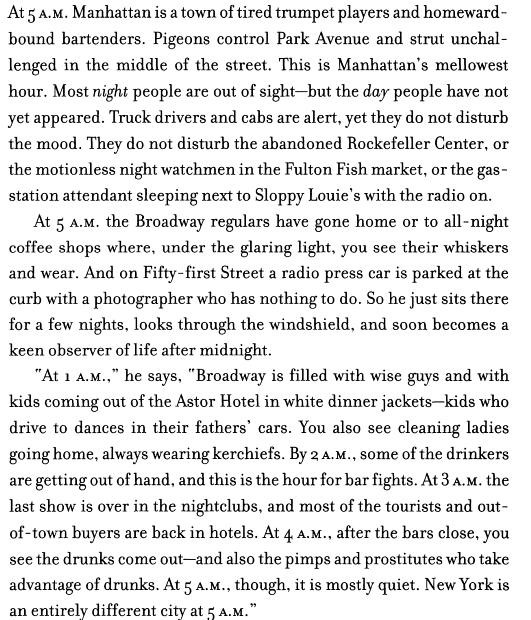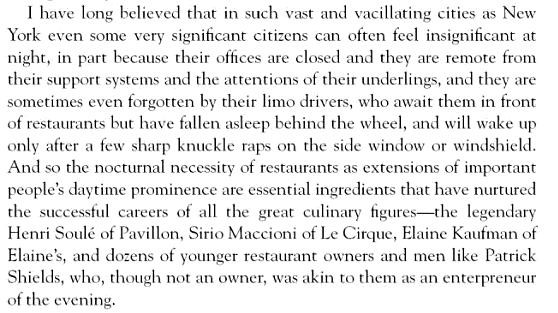John Williams Is 80
by Regina Small
John Williams, composer of the scores for Close Encounters of the Third Kind, Jaws and Raiders of the Lost Ark (among many, many others), turns 80 today. To celebrate, NPR’s Fresh Air tumblr has posted an audio piece from the NPR archives on Williams and the music of Star Wars.
Next Big Leak: Lethal Flu
“The bioterrorism expert responsible for censoring scientific research which could lead to the creation of a devastating pandemic has admitted the information ‘is going to get out’ eventually.”
The Maps We Wandered Into As Kids
The Maps We Wandered Into As Kids
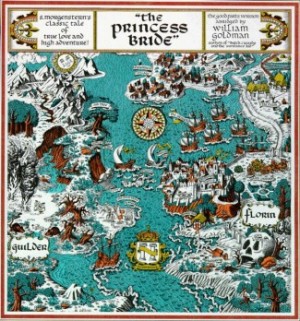
If I ruled the world, or at least a publishing company, all books would contain as much supplementary information as possible. Nonfiction, fiction — doesn’t matter. Every work would have an appendix filled with diagrams, background information, digressions and anecdata. And of course, maps. Lots and lots of maps. This predilection probably sprang from the books I read as a kid — books like The Phantom Tollbooth, The Hobbit and The Princesss Bride — all of which feature engaging maps that serve as gateways to imaginary lands. Here, say these maps, you’re in this other world now.
Norton Juster’s The Phantom Tollbooth
In the beginning of The Phantom Tollbooth, listless youngster Milo wakes up one morning to find a tollbooth has appeared in his room. He also finds a letter that includes “[o]ne (1) map, up to date and carefully drawn by master cartographers, depicting natural and man-made features.” The “master cartographers” here is, actually, the book’s illustrator, cartoonist Jules Feiffer (with some author assist). Feiffer’s involvement with Phantom Tollbooth came about incidentally — he and Norton Juster were neighbors in a Brooklyn Heights apartment bulding. Soon they became close friends,roommates and collaborators. As Feiffer remembers it, he would illustrate passages as Juster read them aloud. But the map was a bit of a sticking point. Feiffer hated to draw two things, horses and maps, and The Phantom Tollbooth included both. Juster sketched out the map’s basic dimensions, which Feiffer then traced and made over into his signature style. If Juster made him draw a map (and at least a few horses), Feiffer was able to sneak in a jab in return: the Whether Man’s appearance, a bald doughball in a toga, is based on Juster. In the 50th-anniversary edition of the book, the author jokes, “This was quite unfair, since everyone knows I never wear a toga.”
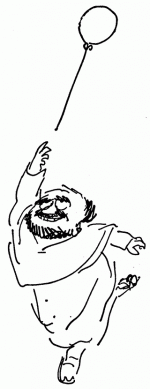
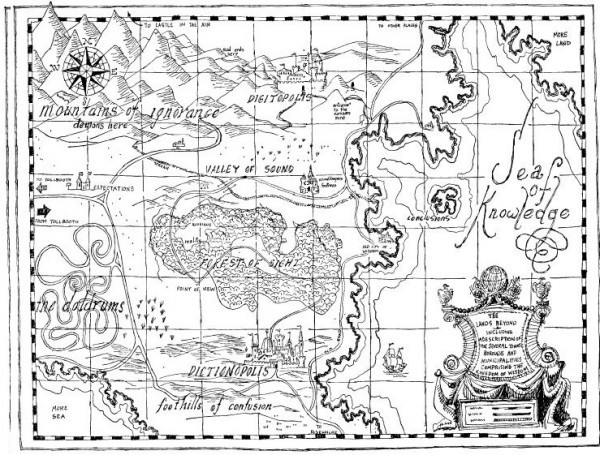
As a map: It’s a perfect example of where hand-drawn aesthetics work best in maps — across a small area mapped specifically for visitors, as the exaggerated landmarks are given weight over exacting spatial accuracy. In this way the unfamiliar can be easily spotted and identified. It’s a style commonly seen in attraction maps, like Anika Mottershaw’s Map of London or theme-park maps, like this one of Walt Disney World.
A.A. Milne’s Winnie the Pooh
The map of the Hundred Acre Wood appears in the first Winnie-the-Pooh book entitled, wait for it, Winnie-the-Pooh. Created by E.H. Shepard (who also illustrated The Wind in The Willows), the map is meant to appear drawn by Christropher Robin, with “Drawn by me and Mr Shepard helpd” written at the bottom and the cardinal directions on the compass marked as P-O-O-H. The storybook woods are based on the actual Five Hundred Acre Wood in Ashdown Forest, near Milne’s country home in Sussex. The original sketch for the map was owned, curiously enough, for a long time by Pat McInally, known in some circles for having the only perfect Wonderlic Test score and also being the first Harvard grad to play in the Super Bowl, which he did for the Cincinnati Bengals in 1981 (zing at you, Ryan Fitzpatick). McInally’s collection, including that preparatory sketch, is currently up for sale at Peter Harrington’s rare book shop in London, yours if you happen to have a spare £115,000 — that’s $182,241.73 — to burn.
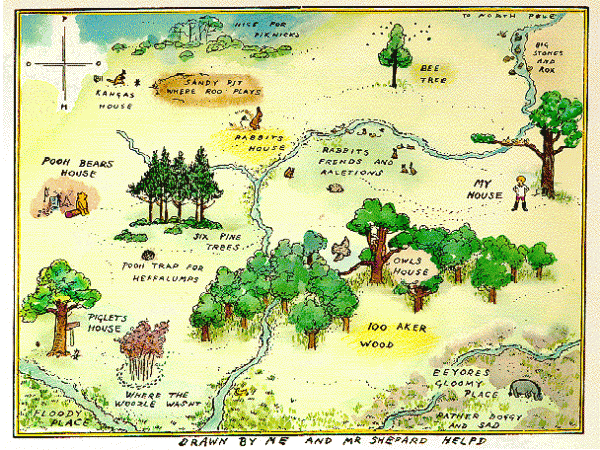
As a map: The key difference between a map like this one and the one from The Phantom Tollbooth is purpose. While Feiffer’s map is intended for exploration, Christopher Robin-E.H. Shepard’s map is a documentation of a known land. In an imaginary world, what’s beyond the borders doesn’t matter so much. Here the only indication of the world beyond is the “To North Pole” note, an obvious sort of landmark for a child’s map. With its focus on the “here” and elision of the “there,” a map of an imaginary world is not unlike early maps, such Hecataeus’ map of the world, drawn in approximately 500 BC, with its amorphous borders of “ocean.” Both Hecataeus and Christopher Robin are making the same point — sure there’s probably other stuff, but this is what’s important.
William Goldman’s The Princess Bride
The Floren and Guilder kingdoms described in The Princess Bride are located “between where Germany and Sweden are today.” For any other geographic particulars about the countries, the reader has to consult the map found in the endpapers (in some editions, a fold-out map in the center), drawn by William Goldman (if other illustrators made the map, I haven’t been able to find a reference to them). The map is a doozy — jammed full of details, landmarks, labels, and with no perspective whatsoever. I mean, the Sun is on this map. The trees are the same size as the ships.
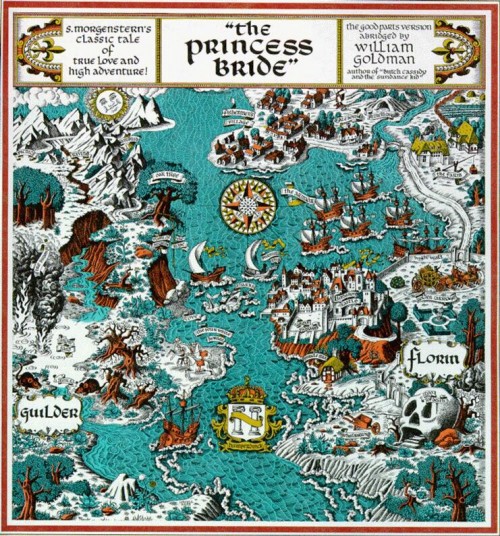
As a map: The map is deliberately evoking the feel of a Medieval illuminated manuscript, as this is an exaggerated version of how many maps looked around the times of princesses and feudal castles. Though examples of these kingdom-level maps are abundant and accessible, I’d like to particularly draw your attention to collection of sixteenth-century maps of Jerusalem, made available by The Jewish National University Library. The gallery beautifully illustrates the diversity to be found in this type of region-specific map. While none of them include the Sun, like Goldman’s map, they often use multiple perspectives to show the mapped lands.
L. Frank Baum’s The Wizard of Oz
All told, Baum drew forty individual maps of Oz to accompany his novel. This is the major one, though, showing the entirety of the land and its surrounding areas. The Emerald City, in the center, is surrounded by four distinct countries. The countries are bordered by deserts (Great Sandy Waste is the obvious winner here and a great potential new name for the litterbox). Beyond the deserts like a number of intriguing countries that make at best a passing appearance in the story, such as Merryland and the Country of Gargoyles. “Kansas” of course appears nowhere.
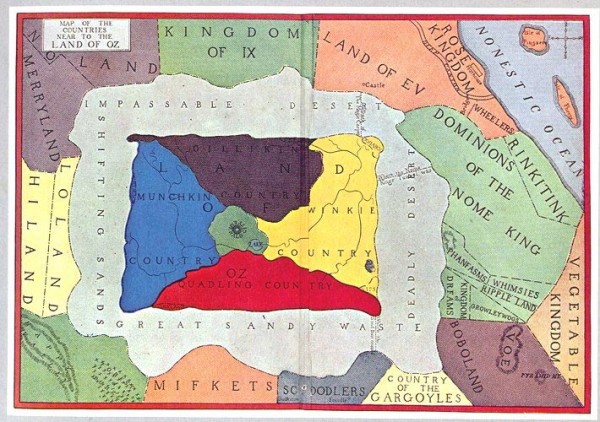
As a map: A straightforward map if ever there was. One thing to note, though: the compass is reversed, East and West are switched. This is an L. Frank Baum original error! The first copy of this map was on a glass slide, when Baum went to make a paper copy he traced it backwards. It’s a great example of a political map — it’s easy to imagine it as a pulldown over the chalkboards of Oz classrooms. I’d direct you to a political map to look at for comparison, but we all know what those look like. Instead, let’s take a peek at the map drawn for Gregory Maguire’s Wicked. First of all, while there’s no North arrow, the cardinal directions have been corrected from Baum’s original. This map gives a more nuanced view of Oz, complete with a legend and some topographical definition. If the first map was a classroom pulldown, this is the map on the quiz at the end of the chapter on which you have to label all the features.
J.R.R. Tolkien’s The Hobbit
Like The Wizard of Oz, The Hobbit contains many, many maps. Most of them were drawn by Tolkien’s son, Christopher, but Thror’s Map was drawn by Tolkien himself. In the story, Gandalf gives this map to Bilbo at the beginning of the story, the impetus for our hero’s “unexpected journey” to recover the dwarves’ treasure from Smaug, the dragon of Erebor.
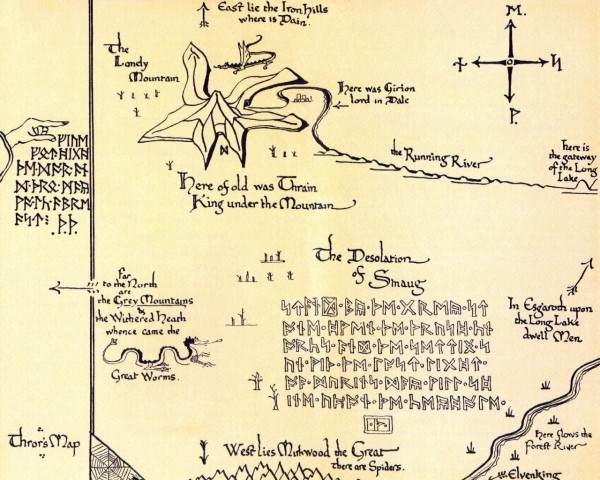
As a map: Drawn more or less to scale, Tolkien’s map shows locations in relation to each other with only sparse detail — only what you absolutely need to know to get where you’re going, no hints of what else is out there. A modern example would be something like this charming map called “Getting Drunk on Passyunk.” Only the information you require, all of the in-betweens omitted. It’s the sort of map you might draw on a napkin for a friend from out of town who isn’t sure where she’s going. “Oh, sure, once you leave my house, you take a left. When you get to the donut shop make another left, then veer right at the house with the spaceship mailbox. If you get to the traffic circle, you’ve gone too far. Presto: you’re at Erebor!”
Ellen Raskin’s The Mysterious Disappearance of Leon (I Mean Noel)
Okay, so this one isn’t a map of an imaginary land — the United States wasn’t conjured out of Raskin’s imagination — but it is a lovely chapter title page. I include it here because a) Ellen Raskin is the bee’s knees and b) this was one of my favorite books as a young girl (I borrowed it from the library so often that the librarians finally just gave it to me one day). In this case, the map serves as a symbol of what’s happening in the book: Protagonist Mrs. Caroline Fish Carillon’s search for her missing husband is centered on her only clue, a half-heard phrase from a drowning man, “Noel(glub) see (blub) all… I (glub) new…”. The power of words, right? Anyway: she takes the final word as an indicator of location and crisscrosses the country to check every town that starts with “New.”
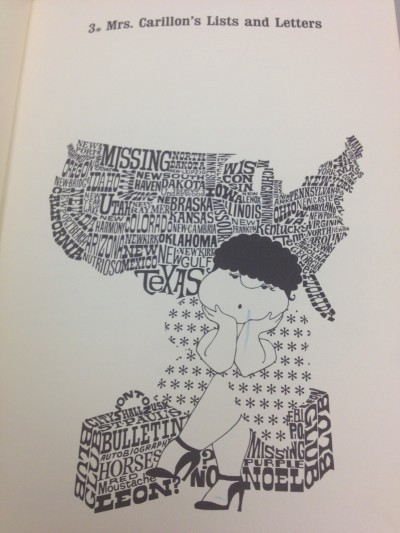
As a map: This typographic style of map has become incredibly popular over the past few years, particularly as a way to show a city by its neighborhoods. But a map made completely of words is nothing new. Edwin Morgan’s Chaffinch Map of Scotland, a poem published in 1965, uses the regional variations of names for a common songbird to create a map of his country. Howard Horowitz’s poem “Manhattan,” reproduced here, appeared in The New York Times in 1997. Flickr user amapple has created a small but impressive set of maps focusing on such linear features as the Mississippi River and the Silk Road. Typographic mapping makes an impact even when the words aren’t locations. National Geographic included a type map of US surnames in its February 2011 issue, and an an interactive viewer is available on their website. My last name is everywhere.
On a final note, I’ll point out a notable map omission from recent literature: I couldn’t believe The Hunger Games didn’t include a map of Panem!!! This is exactly what I meant when I said that books should have as much supplementary information as possible. But evidently, there are a lot of us spatial types out there, and an assortment of reader-drawn maps have popped up. My favorite belongs to Livejournal user “aimmyarrowshigh,” who describes the process she used to determine national borders and each district’s location. The result is a spectacular map that would make any cartographer proud.
Previously: Blame It On Volcanoes and Pictures Of You From Space
Victoria Johnson is The Awl’s resident cartographer. Hobbit and The Princess Bride maps via Woodge.
Do You Enjoy Listening? Then We Have Plans for You for Tonight
by Regina Small
If you’re free TONIGHT (and if you happen to live in New York City; sorry in advance, everyone else!), you can head over to the CUNY Graduate Center at 7p.m. to hear esteemed writers Joan Acocella, Rivka Galchen, Alex Ross and David Samuels talk about something called “long-form journalism.” Never heard of it, but it sounds fascinating.
Take a Day off with Truffaut
by Regina Small
If you have 12.5 hours to spare (or 25 intervals of 30 minutes, up to you),you might enjoy Francois Truffaut’s extremely long interview with Alfred Hitchcock. [Via.]
Who Will Protect Catholics from Rick Santorum?
by Regina Small
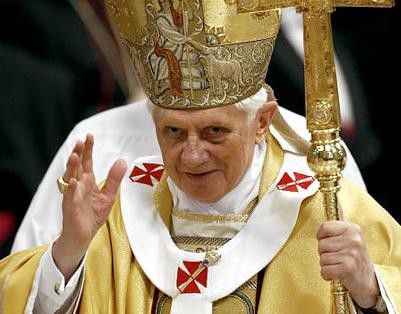
Rick Santorum, eager to show that he will stand up for Catholic values, has been saying things about the recent Health and Human Services regulation that now requires Catholic universities and hospitals to provide access to contraception and the morning-after pill. Santorum has accused the Obama administration of being “hostile to people of faith, particularly Christians and specifically Catholics.” He’s even gone so far as to vow that he “will make it an issue every day of this campaign,” until the Obama administration reinstates conscience protections. Santorum has also spoken up forcefully against same-sex marriage, which the Pope has — yes, again — recently condemned (in some really extreme terms, too).
Santorum further complained that “[The current administration] are folks who are trying to use their power to force people to do things that they believe they should do and are right. They don’t care about their religion.”
But you know who does care about religion? Rick Santorum! In fact, let’s take a look at how most of Rick Santorum’s stated political views are truly representative of the Catholic Church and Catholic voters!
On man-made climate change:
“I for one never bought the hoax. I for one understood just from science, there are 100 factors that influence the climate, to suggest one minor factor of which man’s contribution is a minor factor…. And yet we have politicians running to the ramparts, unfortunately politicians that happen to be running for the Republican nomination of the president who buy into manmade global and bought into cap and trade. Congressman Gingrich and Gov. Romney both supported the idea of manmade global warming and in fact cap and trade; I never did. And unless the science is such that it is a heck of a lot better than what we see today, I won’t.” — Rick Santorum
“I hope that all members of the international community can agree on a responsible, credible and supportive response to this worrisome and complex phenomenon, keeping in mind the needs of the poorest populations and of future generations….In fact, it is by now evident that there is no good future for humanity or for the earth unless we educate everyone toward a style of life that is more responsible toward the created world.” Pope Benedict XVI
On intelligent design:
“Well maybe the science points to the fact that maybe science doesn’t explain all these things. And if it does point to that, then why don’t you pursue that? But you can’t, because it’s not science, but if science is pointing you there how can you say it’s not science? It’s worth the debate.” — -Rick Santorum
“If the model proposed by Darwin is held to be inadequate, one should look for another model. But it is not correct methodology to stray from the field of science pretending to do science…Intelligent design does not belong to science and there is no justification for the pretext that it be taught as a scientific theory alongside the Darwinian explanation.” — -L’Osservatore Romano, the Vatican newspaper.
On the death penalty:
“When there is certainty, that’s the case that capital punishment can be used. If there is not certainty, under the law, it shouldn’t be used.” — Rick Santorum
“There is no room for supporting the death penalty in today’s world.” — -Tommaso Di Ruzza, desk officer at the Vatican’s Pontifical Council for Justice and Peace.
and
Addressing the Sant’Egidio Community in Rome on November 30th, 2011: Pope Benedict XVI stated that he hoped their discussions (organized under the theme “No Justice Without Life”) “will encourage the political and legislative initiatives being promoted in a growing number of countries to eliminate the death penalty.”
On illegal immigrants:
“You can’t be here for 20 years and commit only one illegal act … because everything you’re doing while you’re here is against the law….I understand Congressman Gingrich saying, ‘Well, you know, people have been here and they’ve been good citizens and paying taxes.’ Yeah, under somebody else’s Social Security number because you stole it.” — Rick Santorum
“The Catholic Church’s approach to immigration is not about politics or economics. It is rooted in the vision of human society that was taught to us by Jesus Christ. The Catholic Church, from the time of the first Pentecost, has been a family of nations. By definition, the Catholic Church is universal, one family of God drawn from all nations, peoples, and languages….The point is that in the Catholic Church and in the eyes of God, no one is a stranger or an alien. As a pastor, I am deeply concerned about the costs of this impasse in the lives of millions of men, women, and children. Not just the souls of the 12 million without papers who are living at the margins of our society. I am worried about their physical, moral, and spiritual health. When you are a stranger in a strange land — and unwanted — you are easy prey for exploitation. But more than that. When you are a stranger who is despised, it gets harder every day to hold onto your cultural identity, your moral compass, your religion, your dignity. You start to believe what people say about you — that you are no good.” — Archbishop Jose H. Gomez
On diplomatic relations with Iran:
“I would be saying to the Iranians, you either open up those facilities, you begin to dismantle them and make them available to inspectors, or we will degrade those facilities through air strikes.” — Rick Santorum
“Vatican officials have said privately that on the question of Iran the Holy See supports the position of the IAEA, which has called on Iran to suspend its uranium enrichment program, allow more international inspections and work more cooperatively with the international community to certify that its nuclear development is strictly for peaceful purposes. The officials have also said the Vatican would view outside military intervention in Iran as morally unjustifiable and impractical.” — Catholic News Service Report
On poverty:
“I don’t want to make [black or possibly ‘blah’] people’s lives better by giving them somebody else’s money. I want to give them the opportunity to go out and earn the money and provide for themselves and their families.” — Rick Santorum
“We’ve gotta block-grant [food stamps] and send it back to the states, just like I did with welfare reform — do the same thing with Medicaid, including housing programs, block-grant them, send them back to the states, require work, and you put a time limit on it….We’ll help take these programs, which are now dependencies, and you help people move out of poverty.” — Rick Santorum
“We remind Mr. Gingrich and Mr. Santorum that Catholic bishops describe racism as an ‘intrinsic evil’ and consistently defend vital government programs such as food stamps and unemployment benefits that help struggling Americans. At a time when nearly 1 in 6 Americans live in poverty, charities and the free market alone can’t address the urgent needs of our most vulnerable neighbors. And while jobseekers outnumber job openings 4-to-1, suggesting that the unemployed would rather collect benefits than work is misleading and insulting.” — Letter signed by over 40 Catholic leaders and theologians.
So: Rick Santorum is succeeding in standing up for two stated values of the Catholic Church, while ignoring or outright contradicting most of Catholic social teaching. Is it that these two issues (reproductive freedom, same-sex marriage) actually weigh more heavily in the minds of Catholic voters? Is that why Santorum feels so comfortable identifying as a Catholic politician? Or does the prominence of these two issues in the public discourse about Catholicism have more to do with the Church’s inability to communicate its message about social responsibility and diplomacy? HEAVY QUESTIONS. What we do know is in 2008, 52% of Catholic voters cast their ballots in favor of Barack Obama, a pro-choice candidate, maybe in part because his campaign was more in line with the vast majority of the issues outlined here — in a way Santorum’s isn’t and likely never will be. If Santorum wants to protect the Catholic conscience, it might benefit him to think about what the Catholic conscience actually is.
Cop Chases Himself
“An undercover police officer ‘chased himself round the streets’ for 20 minutes after a CCTV operator mistook him for suspect. As the probationary officer from Sussex Police searched for suspects, the camera operator radioed that he had seen someone ‘acting suspiciously’ in the area. But he failed to realise that it was actually the plain-clothed officer he was watching on the screen, according to details leaked to an industry magazine. The operator directed the officer, who was on foot patrol, as he followed the ‘suspect’ on camera last month, telling his colleague on the ground that he was ‘hot on his heels’.”
Are You Your Friend?

“Would you be your own friend?” I have actually thought about this question as it relates to me personally. I mean, on the plus side, I am always quick to buy the round and happy to share my cigarettes. I am a surprisingly good listener who asks the right questions and usually won’t offer much in the way of advice unless it seems wanted. I do better than average with the commiseration. I can tell a pretty good joke. I will gossip with you about mutual acquaintances in a way that leaves neither of us feeling guilty the next day. I have not thrown up on anyone since high school.
On the other hand, I drink a lot, so I am likely to interrupt you at inopportune moments while I run to the bar for another one. If I’ve had a few too many and something comes on the jukebox that I like I will whistle along. My sarcasm occasionally has too sharp an edge to it, which can be unintentionally hurtful. I have a grating certitude that I understand more about things than is actually the case. I have been known to mansplain. As much as I will listen to you, and I will listen to you as long as you like, I will offer you very little, if any, about my own emotional infrastructure, which I have always thought was an exceedingly polite way to behave but which experience has taught me tends to cause people to feel like they have made themselves bare before me with no gesture of reciprocity. I will keep you out way later than is sensible. So it’s kind of mixed bag.
In the end, I probably would not be friends with me, because, really, what would we have to talk about? But that’s just me. I’m sure you’re a lovely person.
Photo by dabjola, via Shutterstock
Because Why Not, Snow
If the weather were an actor we would all be talking about its phenomenal range. There’s a chance of snow tomorrow, and then it will be back up near 50 on Friday. Next week will probably bring temperatures in the 70s and ice storms. It’s crazy, I tells ya.

